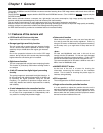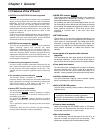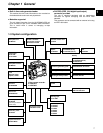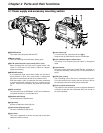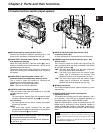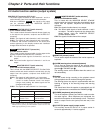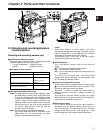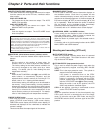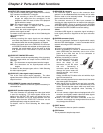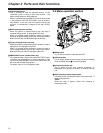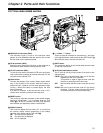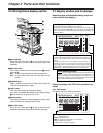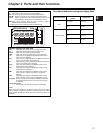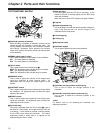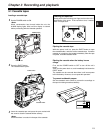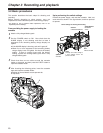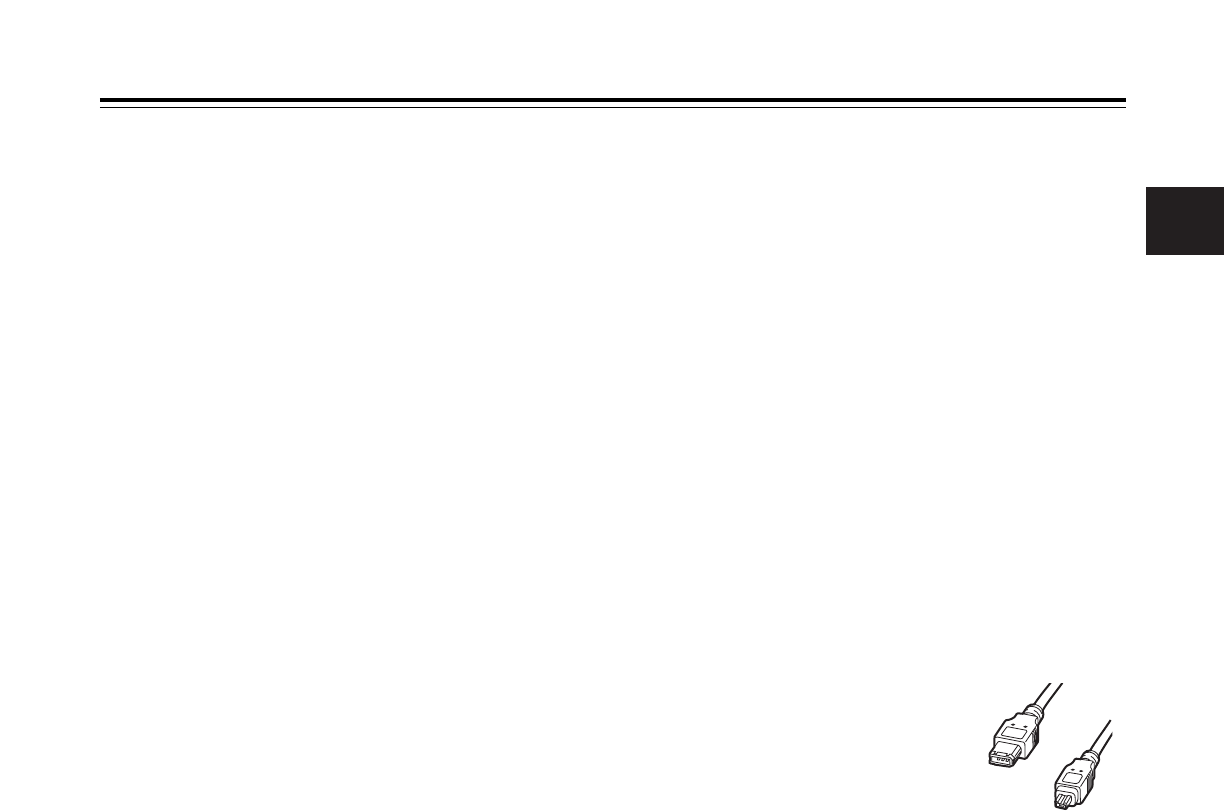
Chapter 2 Parts and their functions
2
13
= OUTPUT SEL (output signal selection) switch
This is used to select the signals output from the VIDEO
OUT connector and MON OUT connector.
VTR : In the recording or other EE mode, the camera
images are output from the connectors; in the
playback or other VV mode, it is the VTR’s playback
signals which are output.
CAM : The camera images are output at all times.
OFF : The video output is stopped and the power
reduction mode is established.
Furthermore, the audio output signals are synchronized
with the video signals as well.
For details on the video output, refer to “4-8-2 Selecting the
video output signals.”
<Notes>
O During recording, the output signals are not switched
even when the position of this switch is changed. They
are switched when the recording operation is stopped.
O When the signals input to the GENLOCK IN connector
or DVCPRO connector are selected as the signals to be
recorded, the switch setting will be the same as at the
VTR position even if the switch is set at the CAM
position.
> VIDEO OUT CHARACTER switch
This is used to control the superimposing of the characters
onto the images which are output from the VIDEO OUT
connector.
ON : The characters are superimposed onto the images.
OFF : The characters are not superimposed onto the
images.
For details on the character types, refer to “4-8-2 Selecting
the video output signals.”
? VIDEO OUT (video signal output) connector
This is the video signal output connector. The video
signals linked to the setting of the OUTPUT SEL switch are
output from here.
@ ECU REMOTE (remote control) connector
The AJ-EC3P extension control unit (optional accessory) is
connected here.
A MON OUT (monitor output) connector
This is the connector for outputting the video signal which
is used for monitoring. The video signals linked to the
setting of the OUTPUT SEL switch are output from here.
Whether characters are to be superimposed onto the
images output from the VIDEO OUT connector can be
selected separately using the internal menu.
For details, refer to “4-8-2 Selecting the video output
signals.”
B GENLOCK IN connector
The reference signal is input to this connector when
genlock is to be established with the camera unit or when
the time code is to be externally locked. This signal can
also be used as the return signal.
The connector serves as a video input connector for
receiving the video signals from an external unit when the
<SYSTEM MODE> screen is opened from the SYSTEM
SETTING page by performing menu operations and VIDEO
is selected as the REC SIGNAL menu item setting.
<Note>
A standard VBS signal (a composite signal including a
burst signal) should be supplied as the input reference
signal.
C DVCPRO connector (6-pin)
This is the input/output connector for signals which comply
with the IEEE 1394 standard. It can be connected with an
external unit using an IEEE 1394 cable.
<Notes>
O Power is not supplied from the unit.
O Before proceeding to connect or disconnect the DV
cable (IEEE1394), be absolutely sure to turn off the
power of the units that are to be connected or
disconnected using this cable.
O Before proceeding to connect
the unit which uses a 6-pin type
of DV connector, carefully
check the shape of the
connectors on the DV cable
and unit. Connecting a
connector upside down may
damage the parts inside the
camera-recorder and cause
malfunctioning.
Always connect the DV cable to the unit with the 6-pin
type DV connector first.
O When recording signals from an external unit, first check
that video signals are supplied.
O While signals from an external unit are being recorded,
do not operate the external unit or disconnect any of its
cables. This will stop the output, which may result in the
signals not being recognized when recording is
resumed.
O You can connect a digital video unit equipped with a DV
connector and digitally transfer video and audio signals
as well as time codes and other information.
O When a DV cable has been connected to the DV
connector, do not apply any strong external force as this
may damage the connector.
D EJECT button
This is pressed to insert or eject the cassette.
E STOP button
This is pressed to stop the tape travel.
6-pin type
4-pin type



